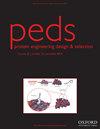计算设计方法的突破为从头开始的蛋白质工程开辟了新的领域。
IF 3.4
4区 生物学
Q3 BIOCHEMISTRY & MOLECULAR BIOLOGY
引用次数: 9
摘要
蛋白质催化生物体中的大多数化学反应,利用这种能力一直是蛋白质工程领域的焦点。计算蛋白质设计的目的是在计算机上创造新的蛋白质和功能,这样做可以加速过程,降低成本,实现更复杂的工程目标。由于计算蛋白质设计方法的几个里程碑式的进步,最近看起来不可能的挑战现在已经触手可及。在这里,我们总结了这些新方法,特别强调在过去5年中发生的蛋白质设计进展。本文章由计算机程序翻译,如有差异,请以英文原文为准。
Breakthroughs in computational design methods open up new frontiers for de novo protein engineering.
Proteins catalyze the majority of chemical reactions in organisms, and harnessing this power has long been the focus of the protein engineering field. Computational protein design aims to create new proteins and functions in silico, and in doing so, accelerate the process, reduce costs and enable more sophisticated engineering goals to be accomplished. Challenges that very recently seemed impossible are now within reach thanks to several landmark advances in computational protein design methods. Here, we summarize these new methods, with a particular emphasis on de novo protein design advancements occurring within the past 5 years.
求助全文
通过发布文献求助,成功后即可免费获取论文全文。
去求助
来源期刊

Protein Engineering Design & Selection
生物-生化与分子生物学
CiteScore
3.30
自引率
4.20%
发文量
14
审稿时长
6-12 weeks
期刊介绍:
Protein Engineering, Design and Selection (PEDS) publishes high-quality research papers and review articles relevant to the engineering, design and selection of proteins for use in biotechnology and therapy, and for understanding the fundamental link between protein sequence, structure, dynamics, function, and evolution.
 求助内容:
求助内容: 应助结果提醒方式:
应助结果提醒方式:


